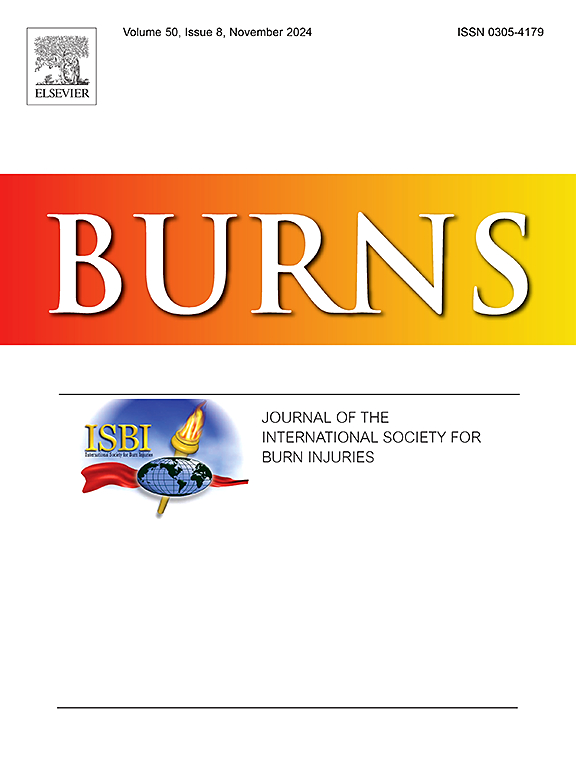Causal links between programmed cell death and hypertrophic scars: Integrative analysis of multi-omics Mendelian randomization and preliminary experimental validation
IF 2.9
3区 医学
Q2 CRITICAL CARE MEDICINE
引用次数: 0
Abstract
Objective
This study aims to explore the causal relationship between programmed cell death (PCD) genes and the formation of hypertrophic scars (HS) using integrative multi-omics analysis (including DNA methylation, gene expression, and protein abundance) alongside preliminary experimental validation.
Methods
We leveraged publicly available databases (eQTL Gen, UKB-PPP, and FinnGen) to obtain quantitative trait loci (QTLs) data of DNA methylation, gene expression and protein abundance. We employed Mendelian randomization (MR) approaches to uncover causal relationships and validate robustness. The methods used included inverse variance weighted (IVW) analysis, false discovery rate (FDR), Cochran's Q test, I² statistic, MR-Egger regression, MR-PRESSO, leave-one-out method, co-localization analysis, and Steiger filtering test. Then, the multi-omic MR results were integrated and three tiers of genes were identified. Further, the tier 1 genes were chosen to perform drug prediction in DSigDB and molecular docking analyses with Autodock Vina. Lastly, the effects of the selected genes and drugs in HS were validated at both the tissue and cellular levels.
Results
Through integrating multi-omics data, we identified one tier 1 gene (GLB1), twelve tier 2 genes (including DAPK2, AP4E1, ARSA, CTSF, MSH6, NEDD4, PDK1, PELI3, RB1, UNC13D, CTSC, and GZMB), and two tier 3 genes (NOS3 and ITGA6), all of which show varying associations with HS. Particularly, the GLB1(cg05120113) was causal associated with HS risk in DNA methylation (OR=1.0972, 95 % CI: 1.0532–1.1430, FDR=0.0163), gene expression (OR=1.2923, 95 % CI: 1.1816–1.4135, FDR<0.001) and protein abundance (OR=1.5430, 95 % CI: 1.3296–1.7905, FDR<0.001). The candidate drugs for GLB1 included Fulvestrant (adjusted P = 0.046, Affinity=-8.8 kcal/mol) and Cyperquat (adjusted P = 0.036, Affinity=-6.2 kcal/mol). Further, the GLB1 expression and inhibitory effect of Fulvestrant were validated in HS tissues and HSFs. Additionally, significant changes in the mRNA and protein expression levels of fibrosis-related markers, including TGF-β1 and α-SMA, were observed in HSFs.
Findings
This study provides robust evidence for the causal involvement of PCD genes in HS formation and identified GLB1 along with 14 other potential genes. Fulvestrant demonstrated therapeutic potential for HS by modulating fibrosis-related pathways in fibroblasts.
程序性细胞死亡和增生性疤痕之间的因果关系:多组学孟德尔随机化的综合分析和初步实验验证
本研究旨在通过综合多组学分析(包括DNA甲基化、基因表达和蛋白质丰度)和初步实验验证,探索程序性细胞死亡(PCD)基因与肥厚性疤痕(HS)形成之间的因果关系。方法利用公共数据库(eQTL Gen、UKB-PPP和FinnGen)获取DNA甲基化、基因表达和蛋白丰度的定量性状位点(qtl)数据。我们采用孟德尔随机化(MR)方法来揭示因果关系并验证稳健性。采用的方法包括方差加权反分析(IVW)、错误发现率(FDR)、Cochran’s Q检验、I²统计、MR-Egger回归、MR-PRESSO、留一法、共定位分析和Steiger滤波检验。然后,对多组MR结果进行整合,鉴定出三层基因。此外,选择第1层基因在DSigDB和Autodock Vina分子对接分析中进行药物预测。最后,在组织和细胞水平上验证了所选基因和药物对HS的作用。结果通过整合多组学数据,我们鉴定出1个一级基因(GLB1), 12个二级基因(包括DAPK2、AP4E1、ARSA、CTSF、MSH6、NEDD4、PDK1、PELI3、RB1、UNC13D、CTSC和GZMB)和2个三级基因(NOS3和ITGA6),这些基因都与HS有不同程度的相关性。特别是,GLB1(cg05120113)与DNA甲基化(OR=1.0972, 95 % CI: 1.0532-1.1430, FDR=0.0163)、基因表达(OR=1.2923, 95 % CI: 1.1816-1.4135, FDR<0.001)和蛋白质丰度(OR=1.5430, 95 % CI: 1.3296-1.7905, FDR<0.001)的HS风险存在因果关系。GLB1的候选药物包括Fulvestrant(调整P = 0.046,Affinity=-8.8 kcal/mol)和Cyperquat(调整P = 0.036,Affinity=-6.2 kcal/mol)。进一步,在HS组织和hsf中验证了Fulvestrant对GLB1的表达和抑制作用。此外,在hsf中,TGF-β1、α-SMA等纤维化相关标志物的mRNA和蛋白表达水平也发生了显著变化。本研究为PCD基因与HS形成的因果关系提供了强有力的证据,并确定了GLB1和其他14个潜在基因。富维司汀通过调节成纤维细胞的纤维化相关通路显示出治疗HS的潜力。
本文章由计算机程序翻译,如有差异,请以英文原文为准。
求助全文
约1分钟内获得全文
求助全文
来源期刊

Burns
医学-皮肤病学
CiteScore
4.50
自引率
18.50%
发文量
304
审稿时长
72 days
期刊介绍:
Burns aims to foster the exchange of information among all engaged in preventing and treating the effects of burns. The journal focuses on clinical, scientific and social aspects of these injuries and covers the prevention of the injury, the epidemiology of such injuries and all aspects of treatment including development of new techniques and technologies and verification of existing ones. Regular features include clinical and scientific papers, state of the art reviews and descriptions of burn-care in practice.
Topics covered by Burns include: the effects of smoke on man and animals, their tissues and cells; the responses to and treatment of patients and animals with chemical injuries to the skin; the biological and clinical effects of cold injuries; surgical techniques which are, or may be relevant to the treatment of burned patients during the acute or reconstructive phase following injury; well controlled laboratory studies of the effectiveness of anti-microbial agents on infection and new materials on scarring and healing; inflammatory responses to injury, effectiveness of related agents and other compounds used to modify the physiological and cellular responses to the injury; experimental studies of burns and the outcome of burn wound healing; regenerative medicine concerning the skin.
 求助内容:
求助内容: 应助结果提醒方式:
应助结果提醒方式:


